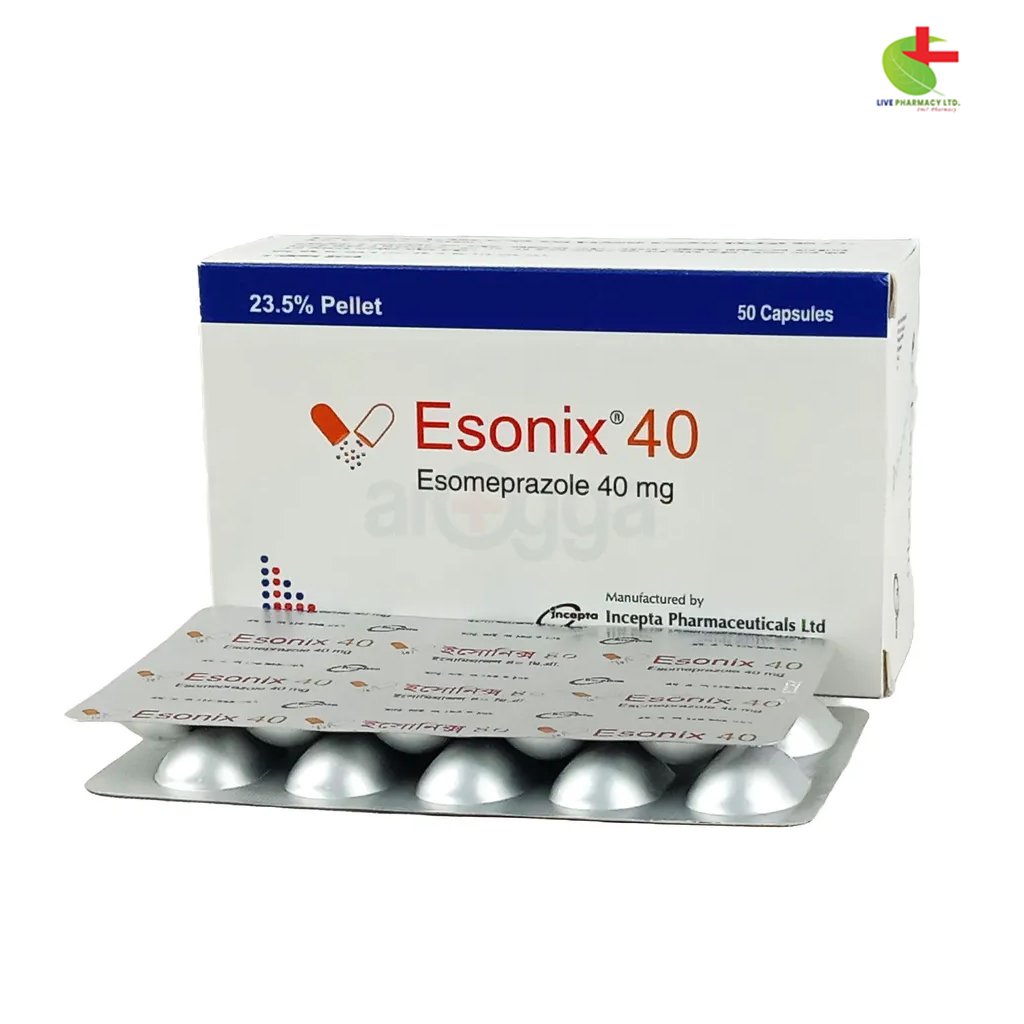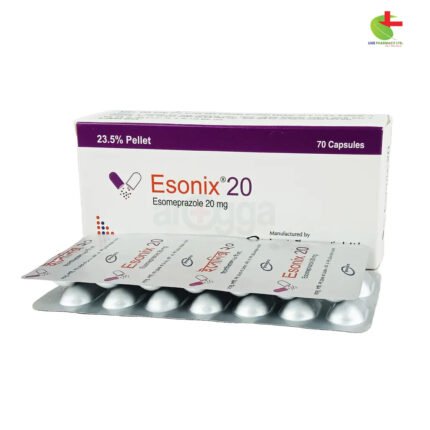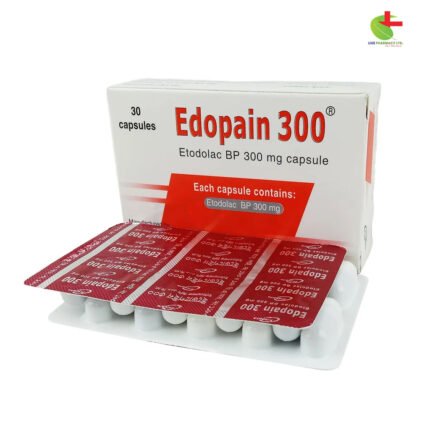Esonix 40
110.00৳ Strip
- Esonix is a proton pump inhibitor indicated for chronic heartburn relief and healing erosive esophagitis.
- It effectively manages GERD symptoms and can be used in combination therapy for H. pylori eradication in duodenal ulcers.
- Esonix has a favorable pharmacokinetic profile, ensuring good absorption.
- Provides targeted treatment for various acid-related conditions.
- Always consult a healthcare professional before use.
 Brand
Brand
|
Incepta Pharmaceuticals Ltd |
|---|---|
 Generics
Generics
|
Esomeprazole |
 Type
Type
|
Capsule |
Indications for Esonix
Esonix is recommended for:
- Alleviating chronic heartburn and other symptoms associated with GERD (Gastroesophageal Reflux Disease).
- Healing erosive esophagitis.
- Maintaining the healing of erosive esophagitis.
- Combined use with amoxicillin and clarithromycin for the eradication of Helicobacter pylori in patients with duodenal ulcers.
- Treating Zollinger-Ellison Syndrome.
- Addressing acid-related dyspepsia.
- Treating duodenal and gastric ulcers.
Pharmacological Overview
Esomeprazole, a proton pump inhibitor, effectively suppresses gastric acid secretion through targeted inhibition of the H+/K+-ATPase enzyme found in gastric parietal cells. As the S-isomer of omeprazole, it is the first single optical isomer of this class, providing superior acid control compared to traditional racemic proton pump inhibitors.
Absorption: Esonix capsules feature an enteric-coated pellet formulation of esomeprazole magnesium. Following oral administration, peak plasma concentrations (Cmax) are reached in about 1.5 hours (Tmax). Increasing the dose results in a proportional rise in Cmax, with a significant increase in the area under the plasma concentration-time curve (AUC) observed from 20 to 40 mg. Daily dosing enhances systemic bioavailability to approximately 90%, compared to 64% after a single dose. Food intake can decrease AUC by 33-53%, so Esonix should be taken at least one hour before meals.
Distribution: Esonex is 97% bound to plasma proteins, and this binding remains consistent across a concentration range of 2 to 20 mmol/L. The apparent volume of distribution at steady state in healthy individuals is around 16 L.
Metabolism: Metabolized extensively in the liver by the cytochrome P450 (CYP) enzyme system, esomeprazole’s metabolites do not exhibit anti-secretory properties. The metabolism primarily involves the CYP2C19 isoenzyme, producing hydroxy and desmethyl metabolites, with some metabolism occurring via CYP3A4, leading to sulphone metabolites.
Excretion: The plasma elimination half-life of esomeprazole ranges from 1 to 1.5 hours. Less than 1% of the unchanged drug is excreted in urine, while about 80% is eliminated as inactive metabolites in urine, with the remainder found in feces.
Combination Therapy with Antimicrobials: For H. pylori eradication, Esonix 40 mg once daily is administered alongside clarithromycin 500 mg twice daily and amoxicillin 1000 mg twice daily for 7 days. This combination results in a 70% increase in AUC and an 18% increase in Cmax for esomeprazole compared to its standalone use. Notably, the pharmacokinetic parameters for clarithromycin and amoxicillin remain consistent, although AUC and Cmax for 14-hydroxyclarithromycin increase by 19% and 22% respectively during combination therapy.
Dosage Guidelines
Oral Dosage Forms:
- Erosive Esophagitis Healing: 20 mg or 40 mg once daily for 4-8 weeks.
- Maintenance of Healing: 20 mg once daily (not studied beyond 6 months).
- Symptomatic GERD: 20 mg once daily for 4 weeks; may extend for another 4 weeks if needed.
- H. pylori Eradication: Triple Therapy: Esonix 40 mg once daily, amoxicillin 1000 mg twice daily, and clarithromycin 500 mg twice daily for 10 days.
- Zollinger-Ellison Syndrome: 20-80 mg once daily, individualized as necessary.
- Acid-related Dyspepsia: 20-40 mg once daily for 2-4 weeks, based on response.
- Duodenal Ulcer: 20 mg once daily for 2-4 weeks.
- Gastric Ulcer: 20-40 mg once daily for 4-8 weeks.
IV Injection or Infusion:
For adults with GERD and erosive esophagitis:
- 20 mg or 40 mg once daily.
- Administer IV injection over 3 minutes or IV infusion over 10-30 minutes.
For pediatric patients (1-17 years):
- <55 kg: 10 mg once daily.
- ≥55 kg: 20 mg once daily.
- 1 month to <1 year: 0.5 mg/kg once daily.
For rebleeding risk reduction in gastric or duodenal ulcers post-therapeutic endoscopy in adults:
- 80 mg IV infusion for 30 minutes, followed by 8 mg/h continuous infusion for 72 hours.
Administration Instructions
- Tablets/Capsules: Swallow whole, at least one hour before meals.
- Oral Suspension: Mix the entire packet contents in 15 ml of water, stir well, and let thicken for 2-3 minutes. Consume within 30 minutes, and if any remains, add more water, stir, and drink immediately. For NG/G-tube administration, ensure proper mixing and prompt administration.
- IV Injection: Prepare by adding 5 ml of 0.9% Sodium Chloride to the vial containing the dry powder. Inject over at least 3 minutes; use prepared solution within 12 hours.
Drug Interactions
Esonix is metabolized by CYP2C19 and CYP3A4. It is not likely to inhibit other CYP enzymes, minimizing the potential for clinically significant interactions. Caution is advised with concurrent use of drugs metabolized by CYP2C19, such as diazepam, which may show increased plasma levels when co-administered with Esonix.
Contraindications
Esonix should not be used by individuals with known hypersensitivity to any of its components.
Side Effects
Common side effects of Esonix may include headache, diarrhea, nausea, flatulence, abdominal pain, constipation, and dry mouth. No significant differences in adverse events have been observed during long-term versus short-term use.
Pregnancy & Lactation
There are no well-controlled studies in pregnant women, and animal studies have shown no teratogenic effects. Breastfeeding should be discontinued if Esonix is deemed necessary for treatment.
Precautions
A symptomatic response to Esonix therapy does not exclude the possibility of gastric malignancy.
Special Population Use
- Pediatric Use: Safety and efficacy have not been established in pediatric patients.
- Geriatric Use: No significant differences in safety and efficacy have been noted between older and younger patients, though increased sensitivity in some older individuals may occur.
- Hepatic Insufficiency: No dosage adjustment is necessary for mild to moderate hepatic impairment; a maximum of 20 mg daily is recommended for severe impairment.
- Renal Insufficiency: Pharmacokinetics in renal impairment are similar to those in healthy individuals.
Overdose Information
Acute toxicity signs from excessive oral doses (510 mg/kg in rats) may include decreased motor activity, respiratory changes, tremors, and convulsions. No specific antidote exists, and management should focus on symptomatic support.
Storage Conditions
Store below 30°C in a dry place, away from light and moisture, and keep out of reach of children.













Reviews
There are no reviews yet.